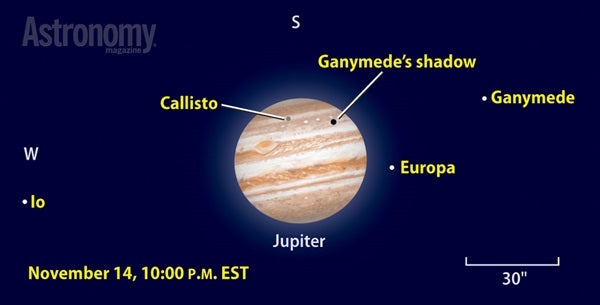The reason is that the inner three Galilean satellites — Io, Europa, and Ganymede — are locked in what is called the “Laplace Resonance,” in which their orbital periods have a ratio of 4:2:1. This means that for every one orbit Ganymede takes, Europa makes two and Io completes four. Io’s volcanoes are, in fact, a direct result of this relationship because the gravity tugs of Europa and Ganymede, combined with the tidal force of Jupiter, produce a continuous source of heat for Io’s interior.
Another consequence of this resonance is that these three moons never can align; whenever Europa overtakes Ganymede, Io is on the opposite side of Jupiter. The closest the three can get is within 60° of one another, and that is not close enough for them to simultaneously transit (cross in front of) or be occulted by (cross behind) Jupiter.
The answer changes if we allow for some of the moons to be in front of Jupiter at the same time that other moons are behind. When viewed through a small telescope, this lineup would still give us the strange appearance that Jupiter had no moons at all. Io, Europa, and Ganymede line up this way during two windows of opportunity per year. These events last up to 2.3 hours, which is the amount of time it takes Io to cross Jupiter’s disk. The next opportunities to see such a triple alignment from North America are December 18 (1h40m to 3h17m UT), December 25 (3h27m to 5h47m UT), and January 1 (6h38m to 7h33m UT). The next chance during warmer weather will be August 11, 2015, from 7h06m to 9h25m UT.
If you’re interested in searching for these events yourself, the SETI Institute has a tool called “Jupiter Moon Tracker,” which makes plots of the positions of Jupiter’s natural satellites relative to the planet. You can find it at http://pds-rings.seti.org/tools.
Callisto is the wildcard Galilean satellite. It does not participate in the Laplace Resonance, so it could be anywhere in its orbit when the inner moons align. Callisto is in front of Jupiter for about 4° of its orbit and behind Jupiter for another 4°, giving us eight chances out of 360 (because 360 is the number of degrees in a circle), or 1 in 45, that it will engage in the alignment.
Let’s put all the math together. If we typically get three alignments of the inner Galileans every six months, but Callisto has only a 1-in-45 chance of participating, then all four will align about once every eight years. During 2014, Callisto is uncooperative and we will not get a quadruple alignment.
Mark your calendar for August 15, 2021, though. From 15h44m to 15h48m UT on that day, Europa, Callisto, and Ganymede will transit Jupiter’s disk while Io passes behind it. If you’re not in a location to see this event, the next quadruple alignment happens July 28, 2033, from 3h46m to 5h02m UT.
SETI Institute, Mountain View, California










